Ploetz, R.C. 2001. Black Sigatoka of Banana.
The Plant Health Instructor.
DOI: 10.1094/PHI-I-2001-0126-02.
Prepared by
Randy Ploetz
Tropical Research and Education Center,
University of Florida, IFAS, Homestead |
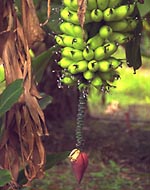 |
Origins and importance of banana as a food crop
Banana is one of the most fascinating and important of all crops. It is a large monocotyledenous herb that originated in Southeast Asia. Virtually all of the cultivars that are grown are thought to have been selected as naturally occurring hybrids in this region by the earliest of farmers. In fact, Norman Simmonds proposed that banana was one of the first crops to be domesticated by man. In writing of the beginnings of agriculture in Southeast Asia, he concluded, "It seems a reasonable assumption that the bananas evolved along with the earliest settled agriculture of that area and may therefore be some tens of thousands of years old."
Despite the current, clear understanding of its ancestry, the edible bananas' origins are often confused in the literature. Almost all of the 300 or more cultivars that are known arose from two seeded, diploid species,
Musa acuminata Colla and
M. balbisiana Colla; they are diploid, triploid and tetraploid hybrids among subspecies of M. acuminata, and between M. acuminata and
M. balbisiana.
Conventionally, the haploid contributions of the respective species to the cultivars are noted with an A and B. For example, the Cavendish cultivars that are the mainstays of the export trades are pure triploid
acuminata and, thus, AAA. The Linnaean species
M. paradisiaca (the AAB plantains) and
M. sapientum (the sweet dessert bananas, of which Silk AAB is the type cultivar) are invalid and no longer used.
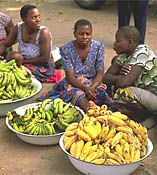
|
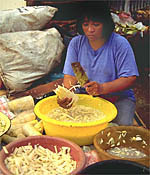
|
Women selling fruit of Dwarf Cavendish AAA and Pisang awak ABB in a market in Karonga, Malawi, East Africa. The lower photograph shows preparation of male buds of Pisang awak for cooking in a market in Sungai Kolok, Thailand. For many of the world’s poorest people, banana is a nutritious and important staple food. |
Banana is now one of the most popular of all fruits. Although it is viewed as only a dessert or an addition to breakfast cereal in most developed countries, it is actually a very important agricultural product. After rice, wheat and milk, it is the fourth most valuable food. In export, it ranks fourth among all agricultural commodities and is the most significant of all fruits, with world trade totaling $2.5 billion annually. Yet, only 10% of the annual global output of 86 million tons enters international commerce. Much of the remaining harvest is consumed by poor subsistence farmers in tropical Africa, America and Asia. For most of the latter producers, banana and plantain (which is a type of banana) are staple foods that represent major dietary sources of carbohydrates, fiber, vitamins A, B6 and C, and potassium, phosphorus and calcium.
|
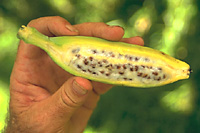
|
|---|

|
This photograph shows seed-packed fruit of
Musa balbisiana, one of the ancestors of the edible bananas. Since the edible cultivars are parthenocarpic and often female or male sterile, seeds are rarely found in their fruit. The latter factors, however, have made it difficult to improve this crop by breeding. |
Impact of banana diseases
Diseases are among the most important factors in banana production worldwide. They are the reasons for which all of the world’s breeding programs were created and remain a primary focus of all current programs. Recently, diseases also became principal targets of biotechnological efforts to improve this crop.
A leaf spot disease is the most important of these problems. Black Sigatoka, which is also known as black leaf streak, causes significant reductions in leaf area, yield losses of 50% or more, and premature ripening, a serious defect in exported fruit. It is more damaging and difficult to control than the related yellow Sigatoka disease, and has a wider host range that includes the plantains and dessert and ABB cooking bananas that are usually not affected by yellow Sigatoka.
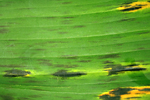
|
|---|
A close-up of the adaxial surface of a banana leaf that is affected by black Sigatoka. Under high rainfall and humidity, these lesions will coalesce and kill the entire leaf.
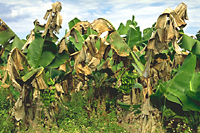
|
Damage caused by black Sigatoka in a planting of Dwarf Cavendish AAA in Malawi, East Africa. Note the scarcity of healthy leaf tissue on plants that carry fruit. Yields from such plants are usually a half or less than that from healthy plants. |
|
In export plantations, Black Sigatoka is controlled with frequent applications of fungicides and cultural practices, such as the removal of affected leaves, and adequate spacing of plants and efficient drainage within plantation. In total, these are very expensive practices. For example, fungicide application includes the use of airplanes or helicopters, permanent landing strips and facilities for mixing and loading the fungicides, and the high recurring expense of the spray materials themselves. In total, it has been estimated that the costs of control are ultimately responsible for 15-20% of the final retail price of these fruit in the importing countries. Their great expense makes them essentially unavailable to small-holder farmers who grow this crop, it is these producers who are affected most by this important disease.
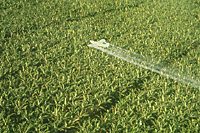 |
|---|
Aerial application of fungicides to control black Sigatoka in Honduras. In the final analysis, the costs associated with these control measures are directly responsible for 15-20% of the purchase price of exported fruit in the importing countries. (Photo courtesy of R.H. Stover). |
Distribution, etiology and epidemiology of black Sigatoka
Black Sigatoka was first recognized in the Sigatoka Valley of Fiji in 1963, but was probably widespread in Southeast Asia and the South Pacific by that time. In the Western Hemisphere, it first appeared in 1972 in Honduras and now occurs on the mainland from central Mexico south to Bolivia and northwestern Brazil, and in the Caribbean basin in Cuba, Jamaica, the Dominican Republic and southern Florida. In Africa, the disease was first recorded in Zambia in 1973 and has since spread throughout the sub-Saharan portions of that continent. In most areas, black Sigatoka has now replaced yellow Sigatoka to become the predominant leaf spot disease of banana.
Black Sigatoka is caused by the ascomycete,
Mycosphaerella fijiensis Morelet [anamorph:
Paracercospora fijiensis (Morelet) Deighton] (a variant of the pathogen,
M. fijiensis var.
difformis, that was previously reported in tropical America, is no longer recognized). The pathogen produces conidia and ascospores, both of which are infective. They are formed under high moisture conditions, and are disseminated by wind, and in the case of conidia, also by rain and irrigation water. Due to their greater abundance and small size, ascospores are more important than conidia in spreading the disease within plants and plantations. In contrast, infected planting material and leaves, which are used often in the developing world as packing materials, are usually responsible for the long-distance spread of the disease. The recent outbreak of black Sigatoka in South Florida almost certainly resulted from the importation of infected germplasm by local growers (see
Plant Disease note D-1998-1217-03N).

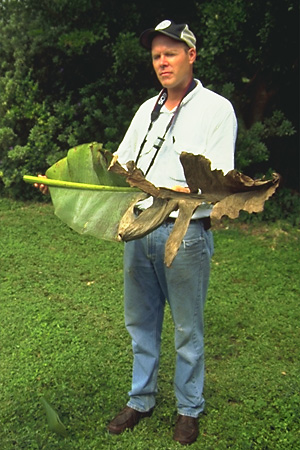


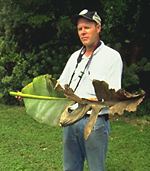
|
"Damn, how did this get here?" Dr. Jonathan Crane, Extension Tropical Fruit Crops Specialist for the University of Florida in Homestead, examines a leaf of the banana cultivar Rajapuri AAB that is affected by black Sigatoka. The importation of infected propagation material, which is a common and effective means for moving this disease long distances, was probably responsible for the recent outbreak of black Sigatoka in South Florida.
|
Control
Chemical control of first yellow, and then black, Sigatoka has evolved considerably over the last 65 years. Bordeaux mixture, first used in the mid-1930s, has been replaced by several succeeding generations of protectant and, later, systemic fungicides. Presently, a sterol biosynthesis inhibitor, tridemorph, several different sterol demethylation inhibitors, most importantly propiconazole, and the methoxyacrylate, azoxystrobin, are the most commonly used systemics.
Since there is a tendency for resistance or tolerance to develop in
M. fijiensis towards the systemic fungicides, they are usually applied in combination or alternation with broad-spectrum, protectant fungicides, such as the dithiocarbamates and chlorothalonil. With the exception of chlorothalonil, these fungicides are usually mixed with petroleum-based spray oils. The oils themselves are fungistatic and retard the development of the pathogen in the infected leaf. When they are mixed in water emulsions with fungicides, the resulting “cocktails” provide superior disease control.
The export plantations in the Philippines and Central and South America that produce fruit for the developed world are vast monocultures of Cavendish cultivars, usually of Grand Nain but also of Williams and Valery. In order to treat these large areas with fungicides, helicopters or fixed wing aircraft are used. Application schedules in the plantations are routinely determined with disease-forecast systems that incorporate data on disease severity within the plantation and environmental factors that are known to affect infection and disease development. These epidemiological tools enabled producers in Central America to substantially reduce the number of fungicide applications that were needed for control. However, increased tolerance in the pathogen to the DMI fungicides has made it necessary to increase applications in several countries in the region to previous frequencies of 25 - 40 per year.
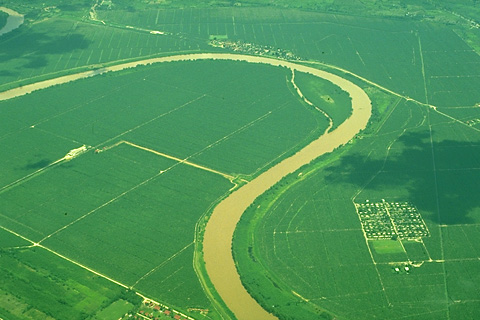
Aerial view of an export plantation of the Cavendish cultivar Grand Nain in the Sula Valley of Honduras. Such vast monocultures allow fruit to be produced efficiently, but require that fungicides for black Sigatoka control be applied by aircraft. |
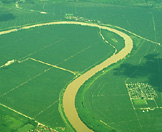
|
The annual cost of fungicide applications in export plantations is about $1,000 per hectare. Although the international trades can add this expense to the price they charge for fruit, this is not an option for subsistence farmers. Thus, the latter producers must use different strategies to manage black Sigatoka. These include the removal of older leaves to reduce inoculum levels in a plantation, interplanting with other nonsusceptible crops, and planting in partial shade which results in less severe disease development.
The potential for bred bananas
Given the high expense of fungicides, their unavailability for subsistence farmers, and the recurring problem with fungicide resistance in the export plantations, it is clear that genetic resistance to black Sigatoka would be most useful. If resistant, agronomically acceptable cultivars were available, they would provide the best solution to this problem in export and subsistence situations alike.
Unfortunately, resistance to black Sigatoka among pre-existing banana genotypes is poor. The Cavendish cultivars that are used for export are so susceptible that nothing short of intensive fungicide application will control the disease in most areas. Resistant cultivars that could be used in subsistence situations are available, but they are usually less productive or desirable than those that are susceptible. This situation has begun to change as a result of new, resistant hybrids that are being developed by the banana breeding programs (http://www.promusa.org ).
The first program to make significant progress in improving this crop was that of the Fundación Hondureña de Investigación Agrícola in La Lima, Honduras. It was begun by the United Fruit Company (now Chiquita Brands
http://www.chiquita.com) in 1959, but was donated to this private agricultural research foundation in 1984. FHIA has developed numerous dessert, plantain and cooking hybrids, several of which have been tested in the International
Musa Testing Programme of the International Network for the Improvement of Banana and Plantain (http://bananas.bioversityinternational.org/). Results from these and other trials indicate that the FHIA clones are generally very vigorous and produce high yields under a wide range of environmental and edaphic conditions. Importantly, they resist pathogenically and geographically diverse populations of
M. fijiensis, as well as two other major problems, Panama disease, (fusarium wilt) and nematodes. Unfortunately, since they do not yet meet the high standards of the export trades, they have only been adopted for local consumption in East Africa, tropical America and the Caribbean.
In the future, products of the breeding programs will play increasingly important roles in subsistence agriculture. Whether new hybrids are used eventually to replace the Cavendish cultivars that are used by the export trades, however, remains to be seen. The very substantial infrastructure that characterizes export production is focussed on producing only these cultivars. Converting these operations to the production and handling of another type of banana would be an expensive proposition. Moreover, the currently available hybrids do not meet the very high standards for fruit quality and post-harvest shelflife that are demanded by the trades. Yet, as fungicides continue to lose their effectiveness against black Sigatoka, and as the practice of fungicidal disease control becomes more expensive and less appealing to consumers in the importing countries, the trades may eventually be forced into making the difficult transition away from the Cavendish clones.
References
1. Carlier, J., X. Mourichon, D. Gonzâlez de León, M.F. Zapater, and M.H Lebrun. 1994. DNA restriction fragment length polymorphisms in
Mycosphaerella species that cause banana leaf spot diseases. Phytopathology 84:751-756.
2. Carreel, F., S. Fauré, D. Gonzâlez de León, P.J.L. Lagoda, X. Perrier, F. Bakry, H. Tezenas du Montcel, C. Lanaud, and J.P. Horry. 1994. Évaluation de la diversité génétique chez les bananiers diploïdes (Musa spp.). Genet. Sel. Evol. 26:125s-136s.
3. Fullerton, R.A., and R.H. Stover (eds.). 1990. Sigatoka Leaf Spot Diseases of Banana: Proceedings of an International Workshop held at San José, Costa Rica, 28 March – 1 April, 1989. INIBAP. Montpellier, France. 374 pp.
4. Gauhl, F. 1994. Epidemiology and Ecology of Black Sigatoka (Mycosphaerella fijiensis Morlet) on Plantain and Banana (Musa spp.) in Costa Rica, Central America. Ph.D. dissertation, Universität Göttingen, 1989. (translated to English from German by INIBAP, Montpellier, France). 120 pp.
5. International Network for the Improvement of Banana and Plantain. 1994. Annual Report, 1993. Montpellier, France. 73 pp.
6. Kress, W.J. 1990. The phylogeny and classification of the Zingiberales. Annals of the Missouri Botanical Garden 77:698-721.
7. Mourichon, X., J. Carlier, and Fouré. 1997. Sigatoka leaf spot diseases.
Musa Disease Fact Sheet No. 8. INIBAP, Montpellier, France. 4 pp.
8. Ortiz, R. 1995.
Musa genetics. In: Gowen, S. (ed.) Bananas and Plantains. Chapman & Hall. London. pp. 84-109
9. Ploetz, R.C., and X. Mourichon. 1999. First report of black Sigatoka in Florida. (Disease Note) Plant Disease 83:300.
10. Rhodes, P.L. 1964. A new banana disease in Fiji. Commonwealth Phytopathological News 10:38-41.
11. Simmonds, N.W. and K. Shepherd. 1955. Taxonomy and origins of cultivated bananas. Journal of the Linneaen Society of Botany (London) 55:302-312.
12. Simmonds, N.W. 1966. Bananas. 2nd edition. Longmans. London. 512 pp.
13. Stover, R.H. 1980. Sigatoka leaf spot diseases of bananas and plantains. Plant Disease 64:750-756.
